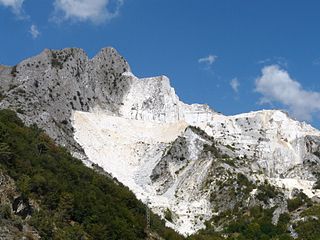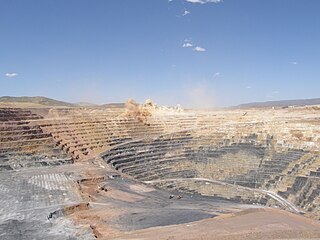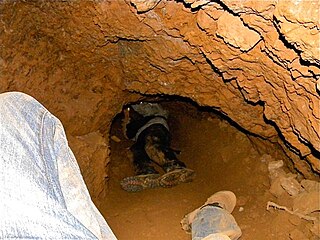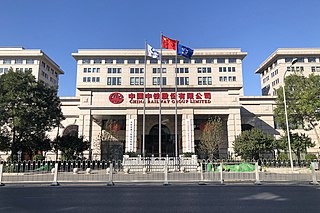
The economy of Eritrea has undergone extreme changes after the War of Independence. It experienced considerable growth in recent years, indicated by an improvement in gross domestic product in 2011 of 8.7 percent and in 2012 of 7.5% over 2011, and has a total of $8.090 billion as of 2020. However, worker remittances from abroad are estimated to account for 32 percent of gross domestic product.

Mining is the extraction of valuable geological materials and minerals from the surface of the Earth. Mining is required to obtain most materials that cannot be grown through agricultural processes, or feasibly created artificially in a laboratory or factory. Ores recovered by mining include metals, coal, oil shale, gemstones, limestone, chalk, dimension stone, rock salt, potash, gravel, and clay. The ore must be a rock or mineral that contains valuable constituent, can be extracted or mined and sold for profit. Mining in a wider sense includes extraction of any non-renewable resource such as petroleum, natural gas, or even water.

A quarry is a type of open-pit mine in which dimension stone, rock, construction aggregate, riprap, sand, gravel, or slate is excavated from the ground. The operation of quarries is regulated in some jurisdictions to manage their safety risks and reduce their environmental impact.

Open-pit mining, also known as open-cast or open-cut mining and in larger contexts mega-mining, is a surface mining technique that extracts rock or minerals from the earth.

The Gold Country is a historic region in the northern portion of the U.S. state of California, that is primarily on the western slope of the Sierra Nevada. It is famed for the mineral deposits and gold mines that attracted waves of immigrants, known as the 49ers, during the 1849 California Gold Rush.

Hegang, is a prefecture-level city in Heilongjiang province of the People's Republic of China, situated in the southeastern section of the Lesser Khingan Range, facing Jiamusi across the Songhua River to the south and Russia's Jewish Autonomous Oblast across the Amur River to the north. Hegang is one of the principal coal-producing cities in China. Hegang covers an administrative area of 14,679.88 km2 (5,667.93 sq mi) and according to the 2020 Chinese census, has a population of 891,271 inhabitants, of whom 545,404 lived in the built-up area made of 6 urban districts.

Yichun (Chinese: 宜春; pinyin: Yíchūn; Wade–Giles: I2-ch'un1; postal: Ichun) is a mountainous prefecture-level city in the western/northwestern Jiangxi Province, China, bordering Hunan province to the west. It is located in the northwest of the province along a river surrounded by mountains. Yichun literally means "pleasant spring". Yichun has a profound Buddhist culture. "Can Lin Qing Gui", the monastic rules for Buddhists at the Buddhist temple, originated from Yichun. Yichun is also the birthplace of a number of literary figures, such as Tao Yuanming and Deng Gu, both of whom are famous poets in China history.
The mining industry in India is a major economic activity which contributes significantly to the economy of India. The gross domestic product (GDP) contribution of the mining industry varies from 2.2% to 2.5% only but going by the GDP of the total industrial sector, it contributes around 10% to 11%. Even mining done on small scale contributes 6% to the entire cost of mineral production. Indian mining industry provides job opportunities to around 700,000 individuals.

Mining in Wales provided a significant source of income to the economy of Wales throughout the nineteenth century and early to mid twentieth century. It was key to the Industrial Revolution in Wales, and to the whole of Great Britain.
In 2006, Cambodia's mineral resources remained, to a large extent, unexplored. Between 2003 and 2006, however, foreign investors from Australia, China, South Korea, Thailand, and the United States began to express their interest in Cambodia's potential for offshore oil and gas as well as such land-based metallic minerals as bauxite, copper, gold, and iron ore, and such industrial minerals as gemstones and limestone.

Daye is a county-level city in eastern Hubei province, China. It is under the administration of the Huangshi prefecture-level city.

Artisanal and small-scale mining (ASM) is a blanket term for a type of subsistence mining involving a miner who may or may not be officially employed by a mining company but works independently, mining minerals using their own resources, usually by hand.

The Thames School of Mines is a nationally significant former school of mining in Thames, New Zealand. It is listed as a Category 1 historic building by Heritage New Zealand.

China Railway Group Limited, known as CREC, is a Chinese construction company which floats in Shanghai and Hong Kong stock exchanges. The major shareholder of the company is the state-owned China Railway Engineering Corporation (CRECG).

The mining industry of Eswatini vests with the Ngwenyama who authorizes mineral rights after due consultation with the Minerals Committee, which he appoints. Fiscal contribution from mining operations to Eswatini's GDP is 2% and also accounts for 2% of export earnings.
The Mining industry of Laos which has received prominent attention with foreign direct investments (FDI) has, since 2003–04, made significant contributions to the economic condition of Laos. More than 540 mineral deposits of gold, copper, zinc, lead and other minerals have been identified, explored and mined. During 2012, the mining and quarrying sector's contribution to GDP was around 7.0%; during this reporting year the FDI in the mineral sector was of the order of US$662.5 million out of a total trade of $4.7 billion in the country. Laos is now a member of the WTO.

Mining is one of the main industries in Malaysia. Malaysia produces aggregate, bauxite, clay, coal, copper, feldspar, gold, gravel, ilmenite, iron ore, kaolin, limestone, mica, monazite, sand, silica sand, struverite and tin.
Wang Jin was a Chinese archaeologist whose research focus was on prehistoric sites in the Jianghan Plain. One of China's first female archaeologists, she was a member of the team that discovered the Neolithic Qujialing culture. She later led the excavation of major sites including the Tonglüshan ancient copper mine and the Shang dynasty city of Panlongcheng. She served as leader of the Hubei Provincial Archaeological Team, Vice Director of Hubei Provincial Museum, and President of the Hubei Archaeological Association.
The Yichun Luming mine is a Chinese molybdenum mine located 60 kilometres (37 mi) south-west of the city of Yichun in Heilongjiang province. The mine is operated by Yichun Luming Mining Company, a subsidiary of China Railway Group. It is the largest open-pit mine in China. On 28 March 2020, the mine had a significant tailings release from its storage facility of 2.53 million cubic metres of polluted water. The Chinese government has launched an investigation into the incident.













